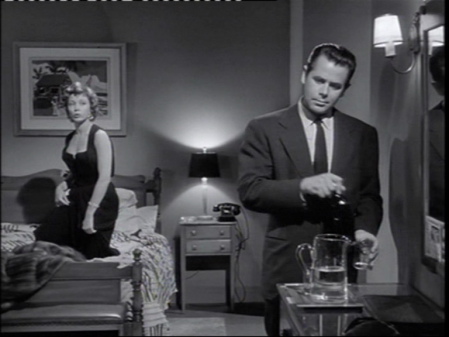A conversation with a friend years ago comes back to me. We debated the strange blandness of the interiors in Fritz lang’s American films. Strange because his German films were known for their elaborate, stylised and striking production design. When he returned to his homeland in the fifties, his Indian duology and to some extent his final Mabuse movie returned to the elaborate sets of the pre-war era. He had trained to be an architect, and gave us the first city of the future. But those American films have a distinct, flat, bleak quality to their look. In THE BIG HEAT, Gloria Graham even comes up with an aperçu to describe the decor: “Early nothing.”
Looking more closely — frame-grabbing, in fact (a new critical weapon which not much has been written about) — I find that, firstly, you have to make an exception for the films with period or foreign settings, where the art direction works hard to create the required exoticism. Secondly, the design isn’t really all that flat. Even a film like WHILE THE CITY SLEEPS, which has a kind of pulpy, comic-book quality to it anyway, isn’t afraid of letting the sets make a splashy statement from time to time.
I think it has more to do with Lang’s shooting style. The distance between the actors is one factor. Lang’s readiness to shoot actors from behind, which you see again and again. His willingness to pull way back and show the characters frozen in longshot, those aforementioned gulfs between them. It turns out Cinemascope isn’t just good for snakes and funerals, it can suck the warmth out of a scene and turn movie stars into distant planetoids signalling to each other in Jodrell Bank bleeps. There are quite a few shots, especially in SECRET BEYOND THE DOOR, which just show empty rooms, abandoned by any visible characters. Lang will flatten the set by shooting it straight on, or creating a crisp geometry even when the angle is more oblique. The very care of his composition, which certainly hasn’t slackened off from the German films, has a cold, clinical quality. The sense of America as a frosty, unwelcoming place, makes the country feel as it might to an exile.
As if al that weren’t enough (it IS enough — it’s too much — STOP!) Lang subdivides the frame, using architectural features, doors, windows, corners, to box his characters into their own little cubicles. Like prisoners in adjacent cells (for obvious genre reasons, cells recur) they can talk to each other but they’re still in solitary. The world is in solitary.

(Lang’s German films were opulent, and so was his home — African masks on the walls, modern art, and all kinds of glamorous, slightly decadent stuff. No wonder he didn’t want to leave, and supposedly hung around almost long enough to be adopted by the Nazis as an official filmmaker — though Lang’s well-practiced anecdote about that may be a convenient fiction.)
Scorsese speaks of the way Lang’s tracking shots make his characters seem fated, in lock-step with their destinies — as if the very nature of the means by which the camera moved made existence a train track towards death. Meanwhile, Lang plotted out the actors’ movements like dance steps, measuring out their paces himself, though Lilli Palmer complained he made no allowance for their difference in stride. So with minute care the figures in his puppet theatre are slid from mark to mark, framed and reframed, staring at each other with longing as they are shuffled like playing cards.
The classic Lang space is the corridor or stairway. All his rooms aspire to the status of interstitial spaces. Comfortless, more empty than full, propitious rooms for murders to happen in. Crime scenes in waiting.
Pics: THE BIG HEAT, YOU ONLY LIVE ONCE, WHILE THE CITY SLEEPS, MINISTRY OF FEAR, THE WOMAN IN THE WINDOW, SECRET BEYOND THE DOOR.










